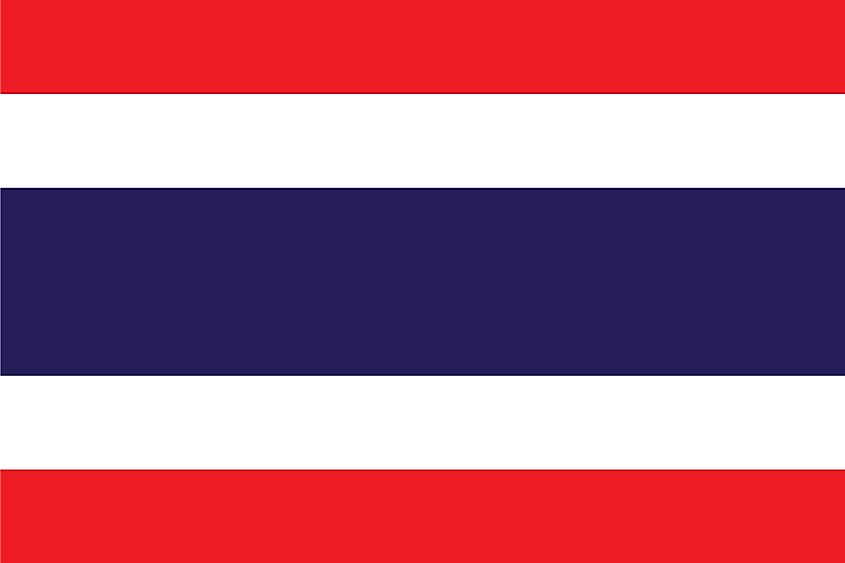
The National Flag of Thailand was officially adopted on September 28, 1917. In the local Thai language, the flag is known as Thong Trairong, which translates to the Tricolor flag.
The National Flag of Thailand features five horizontal bands of red (top), white, blue (double width), white, and red. The red color symbolizes the nation and the blood of life. The white color represents the religion of Buddhism and the purity of the Buddhist faith. The blue color stands for the monarchy. The flag has a width-to-length ratio of 2:3.
History of the Flag of Thailand
The national flag of Thailand has undergone various changes throughout the years. When the country was known as Siam, between 1656 and 1790, the flag was plain red. No symbol was present. However, the look was not distinct enough to be used in international relations and therefore a symbol was to soon follow suit. Between 1790 and1820, a white Chakra was placed at the center of the flag. A chakra is an Indian symbol and the word in Hindu Sanskrit means ‘circle’. In the esoteric religions of India, a chakra is a psychic energy center. Between 1820 and 1855, a white elephant was placed at the center of the Chakra. The elephant has been viewed as the national animal of Thailand. From 1855 to 1893, the chakra was removed leaving the white elephant solely placed at the center of the flag and strategically facing the hoist. From 1893 to 1898, the elephant received a royal makeover with adornments placed on its head and back. Between 1898 and 1917, the flag saw the addition of two new colors, white and blue, and the removal of the elephant from the flag. The blue was meant to honor the Allied Countries during WWI. Interestingly, the color blue was also adopted as the national color of Thailand, and the three flag colors stand for Nation-Religion-Monarchy. The flag was decreed by King Rama VI as the official flag for Thailand in 1917.
Symbols of Thailand
The National Coat of Arms/Emblem of Thailand
The National Coat of Arms/Emblem of Thailand is a Garuda from Buddhist and Hindu mythology. It is also called Phra Khrut Pha. In 1911, Rama VI officially adopted it as the national emblem. In Thailand, the mythological creature Garuda had been a royalty symbol for centuries. It symbolizes divine power and the king’s authority.
National Motto
Chat, Satsana, Phra Maha Kasat (Nation, Religion, King)
National Anthem
- Anthem Title: Phleng Chat Thai (“Thai National Anthem”)
- Music Composer: Phra Chenduriyang (Peter Veit)
- Lyricist: Luang Saranupraphan
- Date of Adoption: December 10,1939.
Phleng Chat Thai (“Thai National Anthem”) is the national anthem of Thailand. The music of the anthem have been composed by Phra Chenduriyang (Peter Veit). The lyrics of the anthem have been authored by Luang Saranupraphan. The anthem was officially adopted on December 10, 1939.
เพลงชาติไทย (Thai)
ประเทศไทยรวมเลือดเนื้อชาติ
เชื้อไทย
เป็นประชารัฐ ไผทของไทย
ทุกส่วน
อยู่ดำรงคงไว้ได้ทั้งมวล
ด้วยไทยล้วนหมาย รักสามัคคี
ไทยนี้รักสงบ แต่ถึงรบไม่
ขลาด
เอกราชจะไม่ให้ใครข่มขี่
สละเลือดทุกหยาดเป็นชาติ
พลี
เถลิงประเทศชาติไทยทวี มีชัย
ชโย
Thai National Anthem
Thailand unites the flesh and blood of Thais.
The land of Thailand belongs to the Thais.
Long has been our independence,
Because Thais have been united forever.
The Thais are peaceful and loving, but are not
cowards in war.
Our sovereignty will never be threatened,
We will sacrifice every drop of our blood for our
nation.
We are ready to die for freedom, security, and
prosperity!
The Currency of Thailand is the Thai baht
The current official currency of Thailand is the Thai baht (฿, THB). It has been the national currency of the Kingdom of Thailand since 1897. Bhat is a decimal currency with a sub-unit “satang”. One Bhat is equal to 100 “satang” and 25 satang make up a “salung”.
Coins
Thai coins in public circulation are of six denominations: 25-satang, 50-satang, ฿1, ฿2, ฿5, and ฿10. Similar to the banknotes, Thai coins with fewer values are smaller in size compared to the more valued ones. All coins, like banknotes, bear a portrait of King Rama IX (Bhumibol Adulyadej) on the front. The reverse sides of the coins feature different temples in Thailand.
Banknotes
Currently circulating banknotes are of the series 15 and 16. These are in the denominations of ฿20, ฿50, ฿100, ฿500, and ฿1,000. The banknotes are designed to draw attention to the contributions of the Chakri Dynasty Kings towards the development of the country. Each denomination note has a different dominant color. The ฿20 banknote’s color is green. The ฿50 banknote is predominantly blue. ฿100-baht banknotes are red. Banknotes of ฿500 denomination are purple and ฿1,000 banknotes are in a brown-gray colored pattern. The size of the banknotes increases with their face value. The ฿20 note is the smallest and ฿1,000 is the largest. The banknotes have a portrait of King Rama IX (Bhumibol Adulyadej) in the front. King Rama IX lived from December 5, 1927, to October 13, 2016. At the time of his death, he was the world’s longest-serving head of state. In the 15th series banknotes, the portrait is in the uniform of the Supreme Commander. However, in the 16th series, the portrait is in the Royal House of Chakri gown. The reverse side of the banknotes depicts images of other kings of the Chakri Dynasty.
Historical currencies of Thailand
Before the adoption of banknotes and flat coins, Thailand used Cowrie Shells (shell of a marine gastropod), Prakab (Baked Clay Coins), and Pot Duang (Bullet coins) as their money. King Mongkut (Rama IV) established diplomatic ties with many countries and implemented free trade. During his reign, an enormous increase in trade led to increased demand for the currency. The Pot Duang coins, which were prevalent at that time, were hand-made and fell short to meet the high demand. There was also wide-spread counterfeiting of the Pot Duangs. Therefore, in 1853, King Mongkut (Rama IV) introduced the paper money, called Mai. However, the public preferred to use Pot Duang and as a result, the Mai failed to meet the king’s objectives. During King Chulalongkorn’s (Rama V) reign in 1873, prices of copper and tin rose in the international markets. This led speculators to melt the coins and ship the metal overseas. As a result, there was an inadequate supply of less valued copper coins in the Thai economy. To address this shortage, the king decreed to issue low-value paper money called Att Kradat (Low-value Paper Money). The Att Kradat was withdrawn in 1875, when new copper coins, from England, were put in circulation. In 1890, the governments prepared to issue paper money called Ngoen Kradat Luang (Treasury Notes), however, due to the inefficiency in banknote management, these notes were never issued. In 1897, the baht became the official currency.







